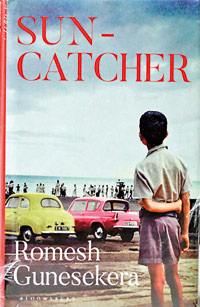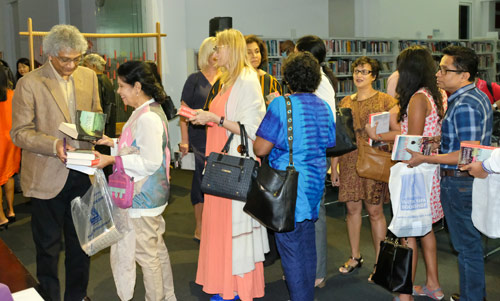Romesh returns with a poetic ode to friendship
 Set in a torpid Colombo with the government in disarray, schools closed, and a red striped milk bar serving ‘Chocolac’ the only hangout for even the Colombo Seven kids, Suncatcher is Romesh Gunesekera’s poignant new novel- a coming of age story which deals with friendship.
Set in a torpid Colombo with the government in disarray, schools closed, and a red striped milk bar serving ‘Chocolac’ the only hangout for even the Colombo Seven kids, Suncatcher is Romesh Gunesekera’s poignant new novel- a coming of age story which deals with friendship.
Last week, London-based Romesh was back in Colombo for the launch of the book at the British Council. While a child at Royal Primary, Colombo- he once confessed- he was “imaginatively planted” in the west. After moving to the UK in 1971, ironically, the books he wrote would mostly hark back to this island. Of these works the most celebrated was the exquisite novel Reef- shortlisted for the Booker Prize in 1994.
Suncatcher takes place in the early 60s- when Kairo meets Jay while cycling near Torrington. In their early teens (Jay a couple of years senior) the two boys begin a friendship which is not what you would call equal: a friendship between the “guide and hero and illumination” and “the acolyte”.
Jay is the former- the charismatic one with a background of affluence which he wears lightly- a golden boy- in fact the ‘suncatcher’ of the title who could do anything (even the Icarus feat of flying up to the sun? – you will find out).

Romesh Gunesekera: A look back. Pix by Amila Gamage
At the British Council, Romesh runs his fingers through his gray mop of hair and despairs, with a smile, about the veritable red herring the name ‘Jay’ has become. Reviewers around the world are staging comparisons with The Great Gatsby by F. Scott Fitzgerald because of Jay Gatsby- which Romesh points out is very shallow of them.
For ‘Jay’ really conjures Jay the bird- the Corvidae whom the Native Americans believed was a magical bird who could change shape- a “beautiful ruthless bird” which, even in European mythology, is a charismatic creature, and is connected to the biblical raven and the crow- a sprite, a sylph with an aura. Equally unintentional, says Romesh, were the connections made with Evelyn Waugh’s novel Brideshead Revisited: Kairo being fascinated by the wealthy Alavises- Jay’s family- is a leitmotif explored in depth in The Sandglass, Romesh’s 1998 novel- and has nothing to do with Brideshead where Charles Ryder is fascinated by Lord Sebastian Flyte’s family.
The glamour of the Alavises is blinding- their white agave-lined house for Kairo is a “gilded castle complete with secret passages, captured animals and a mesmerising queen”- Jay’s beautiful mother Sonya.
When the book came out, the wires ran hot with the news that Romesh’s new novel deals with a deep personal sorrow of having lost a dear friend in childhood.
This was partly true- he did lose a few friends as a child and a teenager, but Suncatcher does not hone in on that experience alone. He had always wanted to write about friendship- the fragility of it and how time changes things. But the book is a ragout of different experiences he had had through life- and part ‘meditation’ on this type of unequal friendships.
But why the 1960s? After Noontide Toll (2013) which was a collage of stories from a very contemporary Sri Lanka, Romesh wanted to go back to a period untouched by ethnic troubles.
At first, Romesh considered the 1970s- the pivotal stage when the magic of old ‘Ceylon’ was morphed into the nationalized ‘Sri Lanka’. But then, the 60s were brightly branded in Romesh’s memory- having lived there before being propelled towards the Philippines and then the UK.
It was a significant epoch in its own way. Writing the first drafts, he realized that this was the juncture where the political parties changed for good, the trajectory being changed for the Lanka Sama Samaja Party and the Left wing’s politics. Kairo’s father interestingly is a Trotskyite- an idler who punts on English horses- and mocks Kairo’s friendship with Jay and the rich Alavis family (alternately scorned as the “petty bourgeois” and ‘landed sloths’).
But the political storms brewing are only gray wisps in the background. What is central is the story of the relationship- and the feeling of loss and guilt after losing a friend.

Autograph time: Romesh obliges eager fans at the book launch
Romesh had, since childhood, had the idea of writing on a friendship being cut short, but it took decades for him to see it in shape as a novel.
Like with all Romesh’s novels, the narrator- Kairo- is a passive person- an ‘impressionable person’ who registers all that is happening- though rarely at the centre of it. He is in fact as sweetly naïve a narrator as you can imagine. He confuses aviaries with ovaries and dreams of pampas and cowboys. When chancing on a strange night time ritual between a man and a woman through a telescope, he reports back to Jay “moon worshippers- kowtowing”.
A poet in essence, Romesh’s novels have always been graced with powerful and exotic symbols. In Suncatcher the central one is the cage, the aviary the two friends are building so Jay’s birds have enough freedom. Reviewers have found the large cage a symbol for “the half freedom of adolescence”, but it is a versatile symbol, and after what happens to Jay, Kairo becomes trapped in a ‘cage of guilt’- while symbolism is also there when monitor lizards and crows attack the aviary- metaphors for dangers awaiting the boys in the adult world.
Our diaspora writers have been offering us bildungsromans set against troubled times in plenty, but Romesh says he never intentionally set out to write a story in that style. He was just interested in the growth and change of the individual but at the same time the ‘growing up of society’- as in this story where the Ceylonese society is “leaving behind a colonial past and coming to a new world- without judgment as to which was better or worse”.
The book, finally, helped Romesh bury some old demons.
“I think I am pleased that I managed to deal with something in my past which I wasn’t sure I would be able to.”
Romesh’s love for nature- perhaps surprising in a postmodern novelist- is woven into a story where the green-billed coucal struts like a ‘sozzle-eyed squire’ and yellow and purple sunbirds chitter and bats swarm at dusk.
The book comes with all the old stunningly poetic Gunesekera magic. It is a complex tale of a deep bond in a vintage world bathed in golden afternoon nostalgia. And it is well worth the seven year wait of all his ardent fans.


